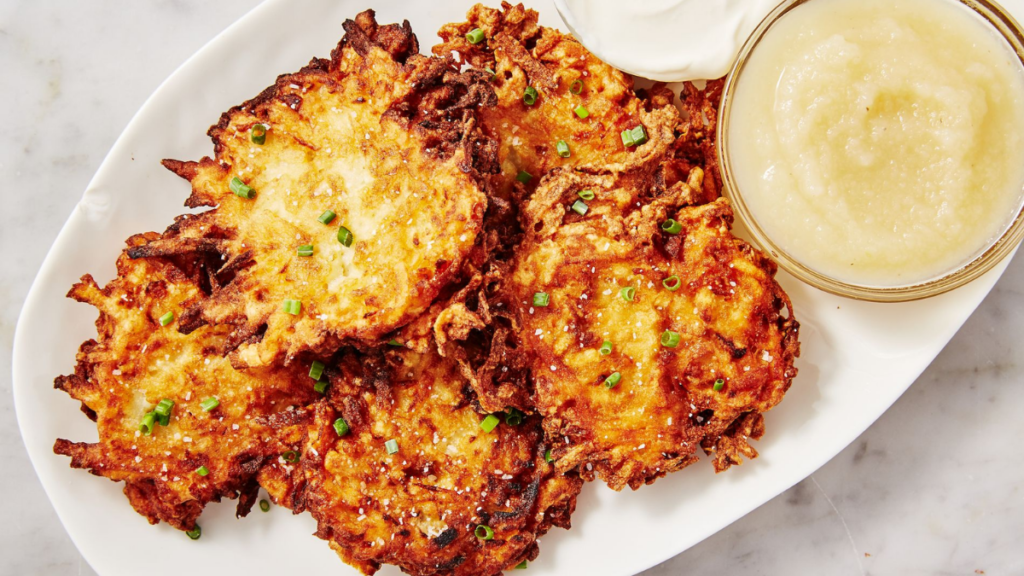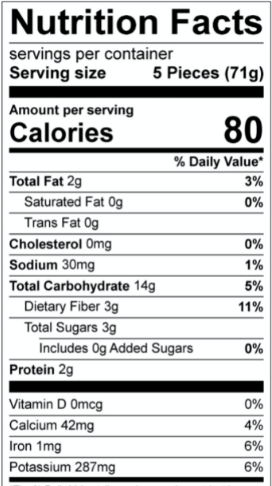What’s the key to perfecting latkes? The crispier the latke, we discovered, the starchier the potato. We tried baking potatoes (the starchiest), Yukon Golds (the least starchy), and boiling potatoes (the least starchy) and enjoyed them all. This recipe can easily be doubled to feed a crowd.
As potato latkes are so simple to prepare, home cooks often overlook them. But while the potato latkes themselves are delicious and nutritious, the cooking process is crucial. A latke frying pan must heat evenly, hold high temperatures, and allow enough room for flipping. Do not use flimsy nonstick pans.
Latkes Nutrition Facts
What Are Latkes?
A latke is a potato pancake or cake usually prepared to celebrate Hanukkah in Ashkenazi Jewish cuisine. Other components that can make latkes include cheese, onion, and zucchini. Latkes are pan-fried potato pancakes made with grated potatoes and onions, an egg, and a binding agent like matzo meal or breadcrumbs. They have a crispy surface and a light, creamy interior in their optimal state. Potato pancakes are rounder than potato latkes, and they’re easier to make uniform. On the other hand, potato latkes are spherical, but you’ll find shredded potato jutting out here and there. Finally, potato pancakes are thinner than latkes, which are thicker.
How To Make Best Latkes?
The crispier the latke, we discovered, the starchier the potato. We tried baking potatoes (the starchiest), Yukon Golds (the least starchy), and boiling potatoes (the least starchy) and enjoyed them all. This recipe can easily be doubled to feed a crowd.
When cooking latkes, it would be best to use a medium-hot skillet or a heavy cast-iron skillet. You should add enough oil to coat the bottom of the pan, and this creates a nonstick surface that prevents the latkes from sticking. Make sure to heat the oil before pouring the batter. The mixture should sizzle in the hot oil. When you see that it is shimmering, you can add the batter and flip it over. The final result should be golden brown, and the fly-away pieces will be extra crispy.
Ingredients
- Two large russet potatoes (about 1 pound), scrubbed and cut lengthwise into quarters
- One large onion (8 ounces), peeled and cut into quarters
- Two large eggs
- ½ cup all-purpose flour
- Two teaspoons coarse kosher salt (or one teaspoon acceptable sea salt), plus more for sprinkling
- One teaspoon of baking powder
- ½ teaspoon freshly ground black pepper
- Safflower or other oil for frying
Preparation
Step 1
Using a food processor with a coarse grating disc, grate the potatoes and onion. Transfer the mixture to a clean dish towel and squeeze and wring out as much of the liquid as possible.
Step 2
Working quickly, transfer the mixture to a large bowl. Add the eggs, flour, salt, baking powder, and pepper, and mix until the flour is absorbed.
Step 3
Pour about 1/4 inch of oil into a medium heavy-bottomed pan over medium-high heat. Use a heaping spoonful to put the batter into the hot pan, frying in batches after the oil is hot (a drop of batter placed in the pan should sizzle). Flatten and shape the drops into discs with a spatula. Flip the latkes when the edges are brown and crispy, about 5 minutes. Cook for another 5 minutes, or until the second side is well browned. While the latkes are still warm, drain them on a paper towel-lined dish and season with salt. Rep with the rest of the batter.
Can You Freeze Latkes?
You can freeze latkes:
- Freeze as soon as possible after you fry them. After draining on a paper towel, place them on a parchment-lined baking sheet in a single layer. Cover with Saran Wrap and place directly in the freezer.
- You can also layer them with parchment paper between layers, but you’ll have to lay them out on separate baking sheets before baking.
- Place directly from the freezer into a hot preheated oven at 400ºF and bake for 10-14 minutes until hot and crispy.
- Occasionally (if I have time and remember), I’ll flip them over halfway through. Serve immediately.
- If you want to prepare lakes ahead of time but not freeze them, you can fry them (about 2-3 hours before) and leave them at room temperature.
- Then, place a single layer on a baking sheet and bake in a hot preheated oven at 400ºF until warm.
What Problem May You Have To Face While Making Latkes?
Here are some making problems with latkes:
Hand-Grating Takes Forever
In some circles, grinding potatoes with a hand grater for 45 minutes or more, peeling your knuckles now and again, and letting the grated potatoes turn a grayish pinkish color is considered a rite of passage. But, honestly, what do you think? It’s inconvenient. Using the food processor’s grating attachment reduces prep time to just a few minutes, and the finished latkes taste even better.
Wringing Out the Potatoes
According to every latke recipe, put the grated potatoes in a dishcloth or cheesecloth and wring them out until no more liquid comes out. It takes a long time and a lot of arm strength to do this task. You could be concerned that you didn’t wring them out thoroughly enough. Instead, toss the grated potatoes into a salad spinner and wring them out. All of the liquid will be thrown out, leaving you with bone-dry shredded potatoes.
Your Latke Batter Is Liquidy
Have you ever thoroughly wrung your potatoes only to discover additional moisture in the bowl after mixing them with the onion and salt? You’re not going to be able to fry that wet combination. What went wrong? There are two possibilities. To begin, your grated onion might be supplying water. Instead of grating it, finely chop it next time.
The Latkes Cook Unevenly
It could be the pan you’re using or the amount of oil you’re using if you wind up with latkes burning in some parts but raw in others. Choose a large pan with a heavy bottom, such as a cast-iron skillet, which warms evenly and maintains heat.
What Is The Difference Between Potato Pancakes And Latkes?
We’re sharing the differences between potato pancakes and potato latkes so you can choose the right recipe. What’s the difference between potato pancakes and potato latkes? Which one should you choose? Is there a real distinction? There are some significant changes, and we will tell you about them so you won’t be disappointed the next time you make them. By the way, we’ve got the best potato pancake and latke recipes for you.
Preparation
Preparing potato pancakes takes a little more time. They must be granted through the grater’s finest (tiniest) holes. Preparing them requires more accuracy, and grating them to the mushy consistency required for pancakes takes longer. Potato latkes are shredded on the grater’s most significant holes, which takes less time. Both require similar materials, including eggs, which aid in the binding process. Some people make their pancakes with a larger batter-to-potatoes ratio than I do, which might result in a lighter, fluffier texture.
Texture
Potato pancakes have a softer texture no matter how they’re made. The batter seems pulpy and watery due to the finely grated potatoes. When fried, they become softer and fluffier, similar to typical pancakes. On the other hand, potato latkes are crisp. You get more of the potato’s natural texture since you grate it into larger shreds, which helps them fry up with the delicious crunchiness latkes are known for.
Taste
Potato pancakes and potato latkes have an incredible potato taste and depend on the seasonings you mix to give them variations in flavor.
Cook
On low-medium heat, potato pancakes require 3–4 minutes on each side, while potato latkes take 4–5 minutes on each side. As a result, potato latkes take a little longer to prepare. I’ve also noticed that while potato pancakes are more of a batter, they splash more across the pan, causing a bigger mess, but potato latkes don’t.


